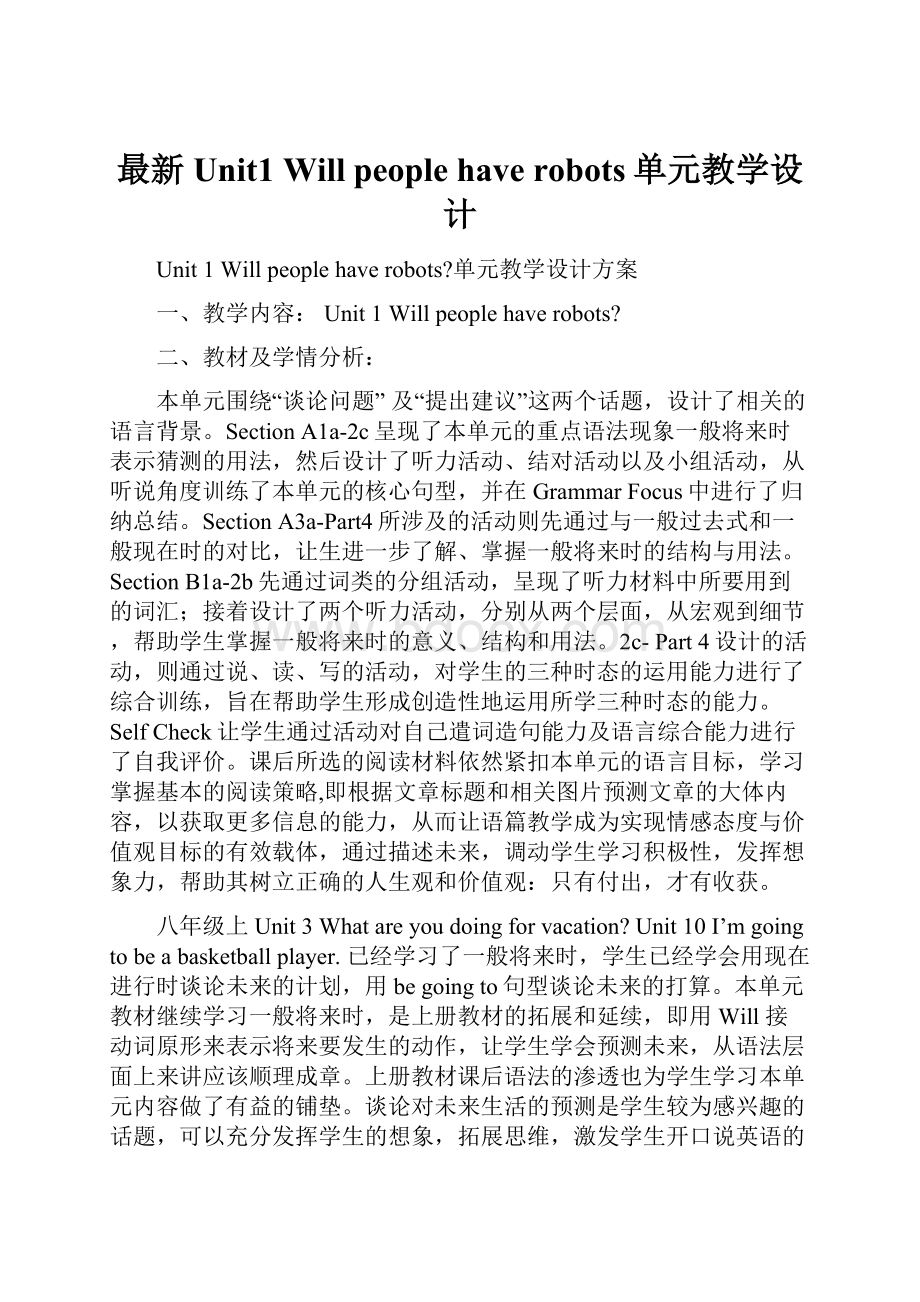最新Unit1 Will people have robots单元教学设计.docx
《最新Unit1 Will people have robots单元教学设计.docx》由会员分享,可在线阅读,更多相关《最新Unit1 Will people have robots单元教学设计.docx(19页珍藏版)》请在冰豆网上搜索。

最新Unit1Willpeoplehaverobots单元教学设计
Unit1Willpeoplehaverobots?
单元教学设计方案
一、教学内容:
Unit1Willpeoplehaverobots?
二、教材及学情分析:
本单元围绕“谈论问题”及“提出建议”这两个话题,设计了相关的语言背景。
SectionA1a-2c呈现了本单元的重点语法现象一般将来时表示猜测的用法,然后设计了听力活动、结对活动以及小组活动,从听说角度训练了本单元的核心句型,并在GrammarFocus中进行了归纳总结。
SectionA3a-Part4所涉及的活动则先通过与一般过去式和一般现在时的对比,让生进一步了解、掌握一般将来时的结构与用法。
SectionB1a-2b先通过词类的分组活动,呈现了听力材料中所要用到的词汇;接着设计了两个听力活动,分别从两个层面,从宏观到细节,帮助学生掌握一般将来时的意义、结构和用法。
2c-Part4设计的活动,则通过说、读、写的活动,对学生的三种时态的运用能力进行了综合训练,旨在帮助学生形成创造性地运用所学三种时态的能力。
SelfCheck让学生通过活动对自己遣词造句能力及语言综合能力进行了自我评价。
课后所选的阅读材料依然紧扣本单元的语言目标,学习掌握基本的阅读策略,即根据文章标题和相关图片预测文章的大体内容,以获取更多信息的能力,从而让语篇教学成为实现情感态度与价值观目标的有效载体,通过描述未来,调动学生学习积极性,发挥想象力,帮助其树立正确的人生观和价值观:
只有付出,才有收获。
八年级上Unit3Whatareyoudoingforvacation?
Unit10I’mgoingtobeabasketballplayer.已经学习了一般将来时,学生已经学会用现在进行时谈论未来的计划,用begoingto句型谈论未来的打算。
本单元教材继续学习一般将来时,是上册教材的拓展和延续,即用Will接动词原形来表示将来要发生的动作,让学生学会预测未来,从语法层面上来讲应该顺理成章。
上册教材课后语法的渗透也为学生学习本单元内容做了有益的铺垫。
谈论对未来生活的预测是学生较为感兴趣的话题,可以充分发挥学生的想象,拓展思维,激发学生开口说英语的欲望,充分调动学生学习的积极性,引导学生深入探究、自主地设计自己未来的生活。
三、单元整体目标分析
1、知识与能力:
1)Tomakepredictions.
2)Totalkaboutfutureintentionsindifferentways.
3)Toreviewthestructure“Therebe”andtheusageof“begoingto”.
4)Toreview“few、little、many、much”,learn“fewer、less、more”andmakesurethestudentscanmasterthedifferencesamongthem.
5)Studentscanpredictwhatthelifewillbelikeinthefutureandtalkabouttheirlifeexperienceandtheirdreamsinthefuturebyusingtargetlanguages.
6)Keywords:
robot,freetime,pollution,astronaut,spacestation,apartment,rocket,moonetc.
2、过程与方法:
Task-basedapproach.
Learningbylistening,speaking,acting,cooperation.reporting,writing.
Encouragethestudentstomakesomecreativeideasandhelpthemtotrytofulfilltheirideas.
3、情感态度与价值观:
1)Everybodyhasadream.
2)Wherethereisawill,thereisaway.
3)Workhard,payoff.
四、重点难点
1)LearnmoreaboutTheSimpleFutureTense.
2)Thelanguagepointsabove.
3)Targetlanguage:
Whatdoyouthinklifewillbelikein100years?
Everyhomewillhavearobot.
Willkidsgotoschool?
No,theywon’t.They’llstudyathome.
Therewillbefewertrees.
五、教学策略与教法选择
依据本单元教材内容以及八年级学生的生活、学习实际,采用情景创设法、交际法和任务型语言教学法。
可供借鉴的教学策略有:
1.直观形象的教学策略:
教学要充分利用网络和多媒体,收集合适的教学资源。
2.教学内容适度的教学策略:
基于课本而不迷信课本。
生活中的例子好,完全可以用生活中了案例,但知识点一定要回归课本。
3.引导鼓励的教学策略:
教学之中要重视学生的情感因素,赏识学生,适时鼓励,学生积极性自然上来了。
4.教学方法多变的教学策略。
各种教学方法轮流使用,贵在恰当。
六、课时及教学内容安排
教学内容
课时安排
任务设计
教法选择
教学环境
SectionA1a,1c,2c
复习导入新课,介入一般将来时will各种句式操练。
Period1
45分钟
1)学习will表将来的用法;2)介绍less,more,fewer的用法;3)in和after的用法区别4)GrammarFocus复习巩固相关表达和语法现象。
讲练法,视听法,交际法,认知法,任务型教学法
多媒体,相关图片及音响
Reading:
Doyouthinkyouwillhaveyourownrobot?
(A)
Period2
45分钟
1)感悟阅读策略:
看标题及图片预测语篇内容。
2)泛读阅读材料以抓住大意。
“三一三”模式;阅读技巧训练。
多媒体,卡纸
1)Reading:
Doyouthinkyouwillhaveyourownrobot?
(B)
2)Listeningpractice:
SectionA1b,2a,2bSectionB2a,2b
Period3
45分钟
1)对阅读材料进行分析,帮助学生解决疑难问题;
2)文中重点句型结构的讲练;
3)处理教材后面设计的问题;
4)听力训练让学生做出正确的选择,巩固三种时态的用法。
听说法,交际法,认知法,任务型教学法
多媒体,卡纸,语音座
学会对未来进行预测;处理SectionA3a,3b,3c,4,SectionB1b,2b
Period4
45分钟
1)操练will表将来句型,学会用will预测未来的工作和生活。
2)写的训练。
3)头脑风暴以复习相关词汇;
4)学习描述过去、现在及未来的相关情况,对比三种时态的用法,学习描述自己10年后的生活。
听说法,交际法,认知法,任务型教学法
多媒体,卡纸
1)SectionB3a.3bPart4andSelfCheck;
2)Revisionofthisunit
Period5
45分钟
1)两个语篇的阅读和讲解;
2)写的训练:
仿写和遣词造句能力的训练。
3)复习本单元知识。
听说法,交际法,认知法,任务型教学法
多媒体,试卷精练。
教学内容
Unit1Willpeoplehaverobots?
SectionA1a.1c.2candGrammarFocus
课时
The1stPeriod
教学对象
ThestudentsofGrade8
设计者
一、教材内容分析
本节课是八年级下第一单元第一课时。
是在上册学习基础上对一般将来时的深入探讨。
教材首先安排了6种预言,让学生予以判断。
本课时为整个单元学习打基础,所以要重点训练语言结构(will+动词原形)、in、after及fewer,less,more的用法区别。
本节课内容体现温故知新,重在呈现相关句型和语言点,最后利用GrammarFocus帮助归纳。
二、教学目标(知识与能力,情感态度与价值观)
1.Knowledgeaims:
⑴words:
will,robot,everything,paper,,fewer,pollution,tree.
⑵Conversation:
Whatareyoudoingforvacation?
I’mgoingsightseeingwithmyfriends.Thetrainisleavinginafewminutes.I’mgoingtobeanactorinthefuture.Willpeopleusemoneyin100years?
B:
No,theywon’t.Everythingwillbefree.Willpeoplelivetobe200yearsold?
A:
Yes,theywill.Etc
(3)Theusageoffewer,less,andmore.
2.Abilityaims:
⑴Learntotalkaboutwhatwillhappeninthefutureusingthetargetlanguage.⑵Learntomakepredictions.
3.Emotionaims:
Learntostudyhard.
三、重点、难点
1)HowtousetheSimplePastTenseandthePresentProgressiveTensecorrectly.
2)Theusageoffewer,less,more,thedifferencesbetween“in”and“after”followedbytime.
四、教法选择与学法指导
本课采用情景创设法、交际法、任务型教学法。
帮助学生温故知新,由进行时表示将来和begoingto表示将来引出will+动词原形表示将来的句式;由few,little,much及many的用法掌握它们的比较级的用法。
五、资源准备1)Acomputerformultimediause.2)Ataperecorder.
六、教学过程
教学任务
教师活动
学生活动
设计意图
及资源准备
Organizationandleadin.
(4min)
1.Greetings.2.FreeTalk.3.Presentthesentences:
Whatareyoudoingfornextvacation?
(Whatareyougoingtodofornextvacation?
Whatwillyoudofornextvacation?
)
Warmup,lookandguess.
ArousetheSs’interestingoflearningandmakeagoodatmosphereforthestudents’learning.
Practicetrainingthesentencepatternsincludingwill.
(8min)
1)Presentthesentencepatternsbychangingallkindsofforms.2)Introducetheusageoffewer,lessandmore.
Listenanddothesentencechangingpractice,takenotes.
Learntomasterthechangingofthepatterns.EnabletheSstolearntosharetheinformationintheirgroups.
Moresentencechangingexercises.
(13min)
Showsomemoreexercises.
Dotheexercisesandtrytounderstandthelanguagegoalwell.
Practicemakesperfect.
Dealwith1a,1c.
(11min)
1.Asksomestudentstotalkaboutmoreaboutthefutureandexpresstheiropinions.
2.LetSsmakeaconversation.
Makeotherpredictions.
Presentandmasterthemainpointsanddifficultpoints.Enablethestudentstousethekeysentencestofinishthetask.
Summary
(7min)
1.Gooverthekeywords.
2.Revisethemainsentencessuchas:
Willpeoplehave…?
Everyhomewillhavearobot.Therewillbemore/less/fewer…Iagree./Idon’tagree.
Listenandthink
Consolidatetheknowledgeofthisperiod.
Homework
(2min)
1.Finishtheexercises.
2.RecitethesentencesinGrammarFocus.
Thinkandwritethemdown.
1.Strengthentheknowledge.2.Enablethestudentstowritewiththekeysentencestheylearned.
七、板书设计
Unit1Willpeoplehaverobots?
1.robotpaperfewerlesspollutionbuildbuildingbuilder
2.…..3yearsago……now….2yearsfromnow…..5yearsfromnow…
Eg,Iwastwelveyearsoneyearago.
Iamthirteenyearsnow.
I’llbeinthisschoolthreeyearsnextyear.
教学内容
Unit1Willpeoplehaverobots?
Reading:
Doyouthinkyouwillhaveyourownrobot?
(1)
课时
The2ndPeriod
教学对象
ThestudentsofGrade8
设计者
一、教材内容分析
本节课是八年级下第一单元第二课时,由单元标题Willpeoplehaverobots?
到阅读材料标题Doyouthinkyouwillhaveyourownrobot?
穿插机器人相关知识,引入阅读材料。
本课时要求学生泛读材料,抓住文章大意,能回答相关问题即可。
在阅读过程中体味阅读策略和相关阅读技巧,以获取更多信息,更好地理解课文。
教师要在问题设计和阅读技巧指导上花些心思。
二、教学目标(知识与能力,情感态度与价值观)
1.Knowledgeaims:
⑴.words:
humans,unpleasant,make,take,shapes,might,lookfor,possible,toothbrushes.⑵Languagepoints:
inthefuture,helpwith,such,wakeup,talkto,overandover,getbored,seemimpossible…
2.Abilityaims:
⑴Readingskillpractice.Learntoknowthemainideasofthetext.⑵Learntoexpressthemselves.
3.Emotionaims:
Learntocommunicatewithothers.
三、重点、难点
1.Learntopredictwhatwe’llreadaboutbylookingatthetitleandthepictures.
2.Thekeystructuresandthelanguagepointsinthetext.
3.HelptheSstocarryoutthereadingstrategy.
四、教法选择与学法指导
经过学习,学生已经学会了对自己的未来生活予以描绘,也可以对未来有些事情进行大胆预测。
这时进行阅读策略教学顺理成章。
可供教师选择的教学方法和策略有:
直观形象的教学策略:
教学要充分利用网络和多媒体,收集合适的教学资源。
2.教学内容适度的教学策略:
基于课本而不迷信课本。
生活中的例子好,完全可以用生活中了案例,但知识点一定要回归课本。
3.引导鼓励的教学策略:
教学之中要重视学生的情感因素,赏识学生,适时鼓励,学生积极性自然上来了。
五、资源准备1)Acomputerformultimediause.2)Somepicturesofrobotsandfuturelife.
六、教学过程
教学任务
教师活动
学生活动
设计意图
及资源准备
Organizationandleadin.
(2min)
1.Greetings.2.FreeTalk.
Dutyreport:
Saysomethingaboutmyfriends’lifeinthefuture.
ArousetheSs’interestingoflearningandrevisetheknowledgelearned.
Section1:
1aand1b.
(8min)
HavetheSsthinkabouttherobotswithsomequestions.
Listenandfillinthechart.
Learntheusesofrobots.EnabletheSspreparebeforereading.Leadin
Getreadyforreading.
(6min)
1.ShowtheSsapictureofrobot,telltheSsabouttherobot.
2.Dividetheclassintopairs.Allowfreediscussionofideasaboutrobots.
3.Askoneortwovolunteerstotelltheclasstheirideas,anddrawtheirrobotontheboard.
Listentotheteacherandreact.
EnabletheSsthinkaboutwhattheymightreadaboutbeforetheyread.Enablethestudentstopracticethereadingskillofpredicting
ComprehensiveReading
(6min)
1.Suggestasecondreadingtoconfirmtheirideasandbuildontheirknowledge.
2.Asksomequestions:
Whatkindofjobsdowewantrobotstodo?
Whichcountryhasrobotsthatcanwalkanddance?
Doallscientistsagreeaboutwhatrobotswillbeabletodo?
Readoncewithoutstoppingforgeneralunderstand.Afterreading,askforashowofhandstoindicatetheyhaveunderstoodthegeneralidea.
Learntounderstandthegeneralideaofthepassage.
Languagepoints
(10min)
1.thesameas,make…do…,totake.2.tohelpdo…,tohelpwith…3.inthefuture2.tohelpdo…,tohelpwith…4.unpleasant,unlike,unhappy,impossible5.such6.hundredsof7.thesameas8.makesb.dosth.9.wakeup10.talktosb.11.overandoveragain12.getbored13.lookfor,looklike,lookat,lookafter14.seemimpossible,ect.
Listenandtakenotes.
Learnthelanguagepoints
Readthetextagain
(5min)
1.Asksomevolunteerstowritesomeexamplesontheboard,orsaythemaloud.
2.Do3c.Ssreadagainandmakealistofalltheusesofrobotsinthefuture.
1.Gothroughthereadingagain.
2.Checkth